This past winter holiday, my family took the trip of a lifetime. We travelled to Quito, Ecuador and from there on to the Galapagos Islands of San Cristobal and Santa Cruz. This is a bucket-list excursion, and we jumped at the opportunity when the stars aligned to make this possible. What I didn’t expect was that this would allow our family to “level-up” in so many ways…
As an educator and father, this was an incredible opportunity to see how my kids learned, and to see the impact of this learning in real-time. I also took advantage and read two incredible books, “The Beak of the Finch” (a story of evolution in our time about a married couple who are biologists studying the finches of the Galapagos for over 30 years. Spoiler alert, evolution occurs WAY faster than we think) and “Galapagos” by Kurt Vonnegut, a distopian novel set a million years in the future, looking back at a apocalyptic event in 1986 that spawned a new type of human. Reading these books situated in the Galapagos deepened my awareness of this incredible UNESCO World Heritage Site and of its importance as a bell-weather for our climate as a whole.
What I learned about learning:
(1) What we teach is out dated.
– Much like my conversation with a teacher about “Doughnut Economics“, many educators know that evolution, Darwin and these islands are understood in different ways now – we have new understandings of how evolution works, what Darwin thought about it, and how these Islands help us understand ourselves on this planet. HOWEVER, we haven’t updated this learning in the classroom. In fact, we had to do some ‘unlearning’! For example, the work of the Grants from “The Beak of the Finch” tells us that evolutionary process are happening all the time, but on a such a scale that we cannot perceive it. What are the implications of this in understanding our own selves, and the evolution of the human species? Too bad we teach to the expectations…
(2) Learning is best done standing still.
– Rest, reflect and being still allows us to sit with our thoughts, it allows us to slow down our thinking in order to observe with depth. On the island of Seymour North, my two sons were still and quiet as they observed the incredible Blue Footed Booby, the Giant Frigates and the sleeping iguanas. They watched and sure they asked some questions, but primarily the excursion to this island was quiet and still. While it has been about 10 days since we were on this island, they still are asking questions, questions that are descriptive “Remember that bird that was this colour, sitting in this type of tree…” which tells me that this seemingly quiet stillness was in fact a furious processing moment for them that they are just now and still articulating.
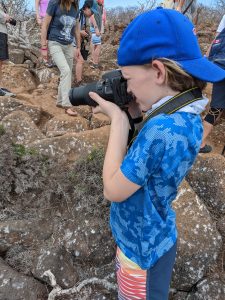
(3) Nothing beats being there! But Be Patient…
This trip will be a watershed moment for our family. The experience won’t leave us, the smells, the sights, the feeling of the incredible heat of the islands, and the cold chill in the rarified air of Quito. Neither will the feeling of the fragility of the planet. In an unfortunate coincidence, there was an oil spill just meters from a beach by our hotel. This was truly a teachable moment, where we talked about it with our kids, and with our guides, and learned more and more about the tenuous balance between raising awareness of the damage done by our very presence, versus the knowledge and understanding that being there gives us. It is not an easy balance, and we are still all processing this. But this cognitive dissonance is not resolved easily, and that will lead us to more thinking and conversations.

“Today, invasions on this (large scale) are happening every day, and virtually every spot o the surface of the planet is being assaulted by varied, new evolutionary pressures. Invaders ride in the puddles of old care tires, the bilge water of ships, the pressurized cabins of airplanes; in suitcases, on pant legs, and on mud-caked shoe soles…The consequence is an intensification of Darwinian pressures not only in the Galapagos but everywhere we look.” (The Beak of the Finch, J. Weiner, pg. 226)
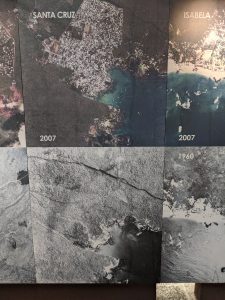
We will talk more about the spraying, the checking of baggage, of wiping down our clothes and luggage before departing Quito to fly to the Galapagos. We will talk about the bins for recycling, waste and compost we saw everywhere; we will talk about the signifigance of staying 2 meters away and never touching the wildlife. We will reflect on the admiration, love and care that each and every
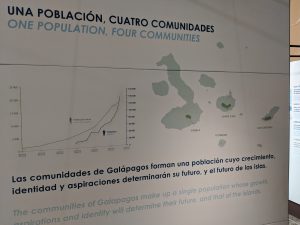
guide we were with has for the land and its flora and fauna. We will talk about how might we bring that same outlook to our own contexts.
(4) Look for ways to See the Parts of the Whole:
The last thing that I will mention, is the importance of the work of UNESCO. The Galapagos, and even where we stayed in Quito, were both designated World Heritage Sites. This designation raises awareness, builds capacity to sustain not only the environment, but also the culture. It brings a depth to these places that situates them in the complexity of change.
It also encourages other organizations to promote peace and understanding, like the hotel where we stayed on San Cristobal (see photo on left). Being a part of, and supporting these initiatives again adds depth and meaning.
Thanks for reading!

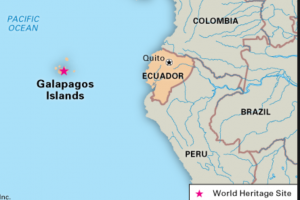

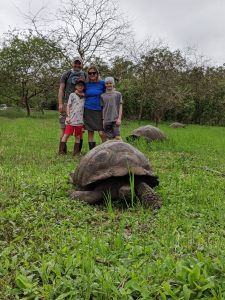
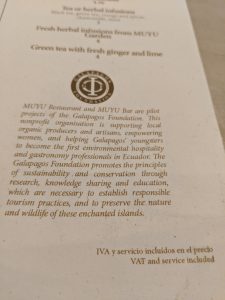

@gnichols,
Just wow. Good for you. Great for your family. Thanks for sharing both your learned and felt experiences.